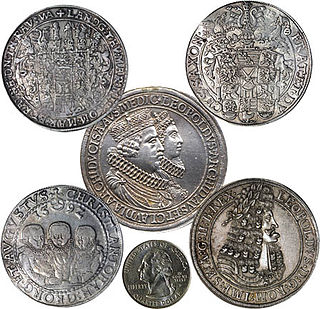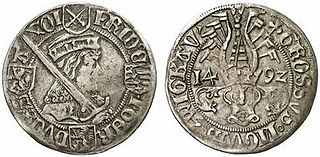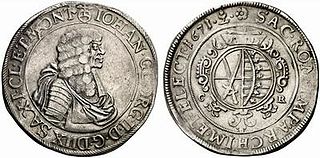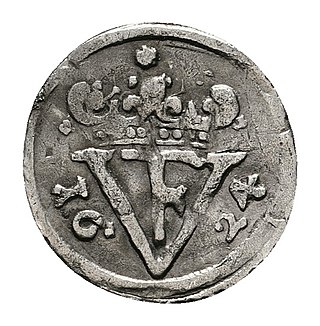
A thaler or taler is one of the large silver coins minted in the states and territories of the Holy Roman Empire and the Habsburg monarchy during the Early Modern period. A thaler size silver coin has a diameter of about 40 mm and a weight of about 25 to 30 grams. The word is shortened from Joachimsthaler, the original thaler coin minted in Joachimsthal, Bohemia, from 1520.

The peso is the monetary unit of several countries in the Americas and the Philippines. Originating in the Spanish Empire, the word peso translates to "weight". In most countries of the Americas, the symbol commonly known as dollar sign, "$", was originally used as an abbreviation of "pesos" and later adopted by the dollar. The dollar itself actually originated from the peso or Spanish dollar in the late 18th century. The sign "₱" is used in the Philippines.

The pfennig ; symbol pf or ₰) or penny is a former German coin or note, which was the official currency from the 9th century until the introduction of the euro in 2002. While a valuable coin during the Middle Ages, it lost its value through the years and was the minor coin of the Mark currencies in the German Reich, West Germany and East Germany, and the reunified Germany until the introduction of the euro. Pfennig was also the name of the subunit of the Danzig mark (1922–1923) and the Danzig gulden (1923–1939) in the Free City of Danzig.

Groschen is the name for various coins, especially a silver coin used in parts of Europe such as France, some of the Italian states, England, various states of the Holy Roman Empire, among others. The word is borrowed from the late Latin description of a tornose, a grossus denarius Turnosus, in English the "thick denarius of Tours". Groschen was frequently abbreviated in old documents to gl, whereby the second letter was not an l, but an abbreviation symbol; later it was written as Gr or g.

The Conventionstaler or Konventionstaler, was a standard silver coin in the Austrian Empire and the southern German states of the Holy Roman Empire from the mid-18th to early 19th-centuries. Its most famous example is the Maria Theresa thaler which is still minted today. The Conventionsgulden was equivalent to a 1⁄2Conventionsthaler.

The Reichsthaler, or more specifically the Reichsthaler specie, was a standard thaler silver coin introduced by the Holy Roman Empire in 1566 for use in all German states, minted in various versions for the next 300 years, and containing 25–26 grams fine silver.

The Austro-Hungarian gulden was the currency of the lands of the House of Habsburg between 1754 and 1892, when it was replaced by the Austro-Hungarian krone as part of the introduction of the gold standard. In Austria, the gulden was initially divided into 60 kreuzers. The currency was decimalized in 1857, using the same names for the unit and subunit.

An Ephraimite was a debased coin part of whose silver content was replaced with copper. Ephraimites, as they came to be called, were issued under the authority of Frederick the Great of Prussia in the Duchy of Saxony and the Kingdom of Prussia from 1756 till 1763 during the Seven Years' War. The coins were spread by merchants and soldiers in Silesia, Bohemia, Poland and Courland and traded as if they were of official silver content. In return higher value foreign coins would be received, which could be used to pay the costs of army supply. By the end of 1762 Frederick the Great abandoned this policy. After the war the traditional content standards were restored.

The history of Saxon coinage or Meissen-Saxon coinage comprises three major periods: the high medieval regional pfennig period, the late medieval pfennig period and the thaler period, which ended with the introduction of the mark in 1871/72. Rich silver deposits, which were discovered near Freiberg after the middle of the 12th century, helped Saxony to a leading position in German coinage.

The Bartgroschen was a Saxon coin minted in 1492 and 1493 and embossed with an image of the bearded Duke Frederick III, the Wise (1486–1525). A total of 205,000 pieces were struck at the mints of Zwickau and Schneeberg. The groschen were the first Saxon coins with a portrait of the regent.

The Meissen groschen or broad groschen was a Meissen-Saxon silver coin of the 14th and 15th centuries and the regional currency of the Margraviate of Meissen in the Late Middle Ages. It was introduced by Margrave Frederick II of Meissen in 1338/39 and modelled on the Prague groschen.

The Wechselthaler, also spelt Wechseltaler or Wechsel-Thaler, was minted in 1670 and 1671 in the Electorate of Saxony under Elector John George II (1656–1680) to the Wechselthaler or Burgundian thaler standard (861/1000 fineness). As the name suggests, the Wechselthaler and its subdivisions were intended as a currency to encourage Leipzig's trade with Hamburg and the Netherlands. The first coins from 1670 therefore bear the inscription WECHSELTHALER on the reverse. The Wechselthaler standard was only valid in Electoral Saxony in 1670 and 1671.
The Speciesthaler, also Speciestaler or Speziestaler, was a type of silver specie coin that was widespread from the 17th to the 19th century and was based on the 9-Thaler standard of the original Reichsthaler. In Scandinavian sources the term Speciesdaler is used and, in German sources, the abbreviation Species was also common.
The Reichsmünzfuß was a coinage standard or Münzfuß officially adopted for general use in the Holy Roman Empire. Different imperial coin standards were defined for different types of coins.
A Münzfuß is an historical term, used especially in the Holy Roman Empire, for an official minting or coinage standard that determines how many coins of a given type were to be struck from a specified unit of weight of precious metal. The Münzfuß, or Fuß ("foot") for short in numismatics, determined a coin's fineness, i.e. how much of a precious metal it would contain. Mintmaster Julian Eberhard Volckmar Claus defined the standard in his 1753 work, Kurzgefaßte Anleitung zum Probieren und Münzen, as follows: "The appropriate proportion of metals and the weight of the coin, measured according to their internal and external worth, or determined according to their quality, additives and fineness, number and weight, is called the Münzfuß."

The Guter Groschen, also Gutergroschen or Gutegroschen, abbreviation Ggr., is name of the groschen coin that was valued at 1⁄24 of a Reichsthaler from the end of the 16th century. It was called a "good groschen" to distinguish it from the lighter Mariengroschen, which was only valued at 1⁄36 Reichsthaler. The term Guter Groschen remained common until the middle of the 19th century.

The Bauerngroschen, also Burgroschen, was a groschen minted in the Free Imperial City of Goslar from 1477 until at least 1490 and continued to circulate until the 16th century. On the obverse it depicts a coat of arms with an imperial eagle beneath a helmet with a crown and on the reverse Saints, Simon and Jude. The two apostles were thought by the people to be farmers due to the poor quality stamping of the coins, hence the name, Bauerngroschen.

The schilling was the name of a coin in various historical European states and which gave its name to the English shilling. The schilling was a former currency in many of the German-speaking states of the Holy Roman Empire, including the Hanseatic city states of Hamburg and Lübeck, the March of Brandenburg, and the Duchies of Bavaria, Mecklenburg, and Württemberg. It was also used in Switzerland and in Austria, where silver schillings were introduced as recently as 1923.

The Matthiasgroschen, Matthier or Mattier is the name of various north German groschen coins of the 15th to 18th centuries.

The Sechsling, also Sößling, Søsling (Dan./Norw.) or Sechser, was the name of a type of coin with a value of six Pfennigs, representing half a Groschen or half Schilling depending on the monetary system.





















